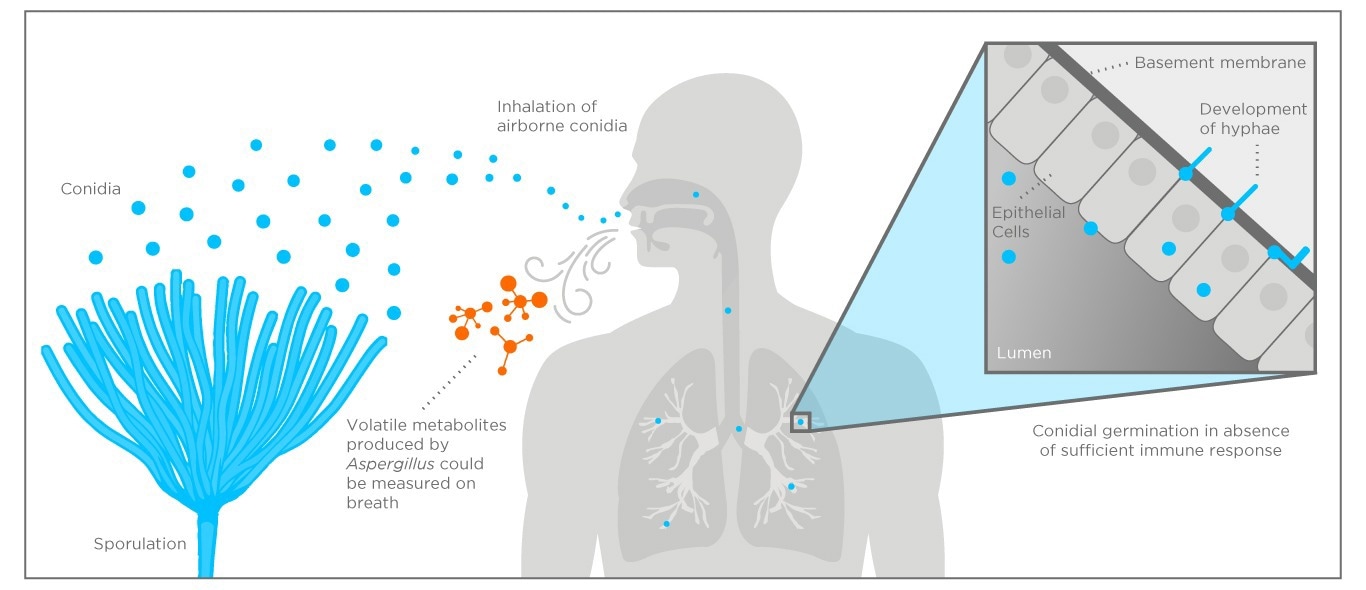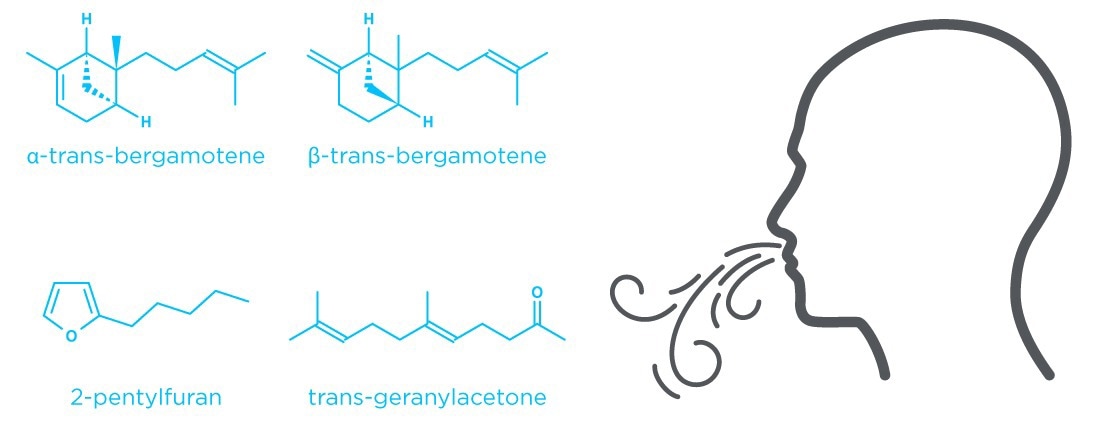Aspergillosis is a fungal infection caused by different species of the fungus Aspergillus, commonly found in decaying organic material.
While the majority of individuals who inhale Aspergillus spores are unaffected, those with underlying respiratory conditions or those immunocompromised can be vulnerable to becoming critically ill from invasive aspergillosis with a mortality rate of between 40% and 90%.1
Despite ongoing progress in anti-fungal treatments, the mortality rate remains high. This is partly due to the complexities of making an early diagnosis of the disease.
The chance of a positive prognosis can be improved by ensuring timely access to reatment, but the symptoms of aspergillosis can be non-specific. Radiologic findings are often associated with other diseases, cell cultures lack sensitivity and need time for incubation, and definitive diagnosis is contingent on a tissue biopsy of the lung.2
There is a definitive need for a non-invasive method of reliable, early diagnosis of aspergillosis, and breath analysis could offer the solution.
Why is aspergillosis so dangerous for transplant patients?
The opportunistic characteristics of Aspergillosis put transplant patients at particular risk as they are one of the most vulnerable, immunosuppressed hosts. The reported infection rate of invasive aspergillosis is around 15% in transplant patients, partly due to the immunosuppressant drugs required for successful transplantation.3
Aspergillus fumigatus is considered to be the species most commonly associated with invasive aspergillosis.
When this pathogen is inhaled, and airborne conidia (asexual spores) are deposited in the bronchioles or alveolar spaces, the immune response is initiated. This immune response involves alveolar macrophages that destroy the fungal spores via phagocytosis, and recruit neutrophils that eliminate any germinating hyphae.4

Figure 1. Conidia germinate in immunosuppressed patients, leading to debilitating symptoms. Volatile secondary metabolite produced by Aspergillus can be detected on breath. Adaped from Dagenais et al (2009).
The pathology will vary if the host’s immune system is compromised, depending on whether the patient has neutropenia or corticosteroid-induced immunosuppression.
This may consist of accelerated hyphal growth, clotting, hemorrhage, and propagation to other organs, and the possibility of developing limited pyogranulomatous infiltrates, tissue necrosis, and excessive inflammation, respectively.4
Those with suppressed immune systems struggle to fight against the infection without treatment. If left untreated, this can lead to severe health damage and even death.
Breath analysis: Detecting invasive aspergillosis with fungal metabolites
Aspergillus fumigatus can synthesize at least 226 secondary metabolic products. Each possesses antibiotic, phytotoxic, or cytotoxic properties, influencing the interactions between fungi and the body.3
The unique metabolic processes of fungi mean that most of these products will not occur via endogenous processes in human metabolism. Therefore, they could potentially serve as practical exogenous biomarkers of invasive aspergillosis.
It has been revealed that several distinct metabolites that Aspergillus fumigatus produces are volatile compounds, including camphene, α- and β-pinene, limonene, α- and β-trans-bergamotene, and 2-pentylfuran during in vitro testing.3,5
Measuring a patient’s breath for α- and β-trans-bergamotene, trans-geranyl acetone, and 2-pentyl furan shows an ability to distinguish those with invasive aspergillosis from healthy control groups.3,5

Figure 2. Secondary metabolites found on breath in patients with invasive aspergillosis and not in healthy controls. Image Credit: Owlstone Medical Ltd
The role of Breath Biopsy® in advancing invasive aspergillosis research
Upon further verification, it is possible that volatile metabolites could serve as non-invasive markers for the early detection of invasive aspergillosis and help monitor the effectiveness of antifungal treatments. Consequently, continued investigation into these potential biomarkers is critical for lowering the disease's high mortality rate and enhancing patient outcomes.
To learn more about incorporating Breath Biopsy into aspergillosis research, contact Owlstone.
References and further reading
- Swu-Jane Lin, Jennifer Schranz, Steven M. Teutsch, Aspergillosis Case-Fatality Rate: Systematic Review of the Literature, Clinical Infectious Diseases, Volume 32, Issue 3, 1 February 2001, Pages 358–366. DOI: 10.1086/318483
- Koo S, Thomas HR, Daniels SD, Lynch RC, Fortier SM, Shea MM, Rearden P, Comolli JC, Baden LR, Marty FM. A breath fungal secondary metabolite signature to diagnose invasive aspergillosis. Clin Infect Dis. 2014 Dec 15;59(12):1733-40. DOI: 10.1093/cid/ciu725
- Singh N, Paterson DL. Aspergillus infections in transplant recipients. Clin Microbiol Rev. 2005 Jan;18(1):44-69. DOI: 10.1128/CMR.18.1.44-69.2005
- Dagenais TR, Keller NP. Pathogenesis of Aspergillus fumigatus in Invasive Aspergillosis. Clin Microbiol Rev. 2009 Jul;22(3):447-65. DOI: 10.1128/CMR.00055-08
- Syhre M, Scotter JM, Chambers ST. Investigation into the production of 2-Pentylfuran by Aspergillus fumigatus and other respiratory pathogens in vitro and human breath samples. Med Mycol. 2008 May;46(3):209-15. DOI: 10.1080/13693780701753800
About Owlstone Medical Ltd
Owlstone Medical is developing a breathalyzer with a focus on non-invasive diagnostics for cancer, inflammatory disease and infectious disease, the company aims to save 100,000 lives and $1.5B in healthcare costs.
The company’s Breath Biopsy® platform has introduced a new diagnostic modality making it possible to discover novel non-invasive biomarkers in breath using a platform with the potential to transition to point-of-care. The award winning ReCIVA Breath Sampler ensures reliable collection of breath samples.
Breath Biopsy is supporting research into early detection and precision medicine with applications in cancer and a wide range of other medical conditions. Highly sensitive and selective, these tests allow for early diagnosis when treatments are more effective and more lives can be saved.
Sponsored Content Policy: News-Medical.net publishes articles and related content that may be derived from sources where we have existing commercial relationships, provided such content adds value to the core editorial ethos of News-Medical.Net which is to educate and inform site visitors interested in medical research, science, medical devices and treatments.